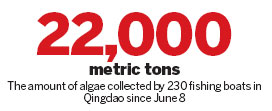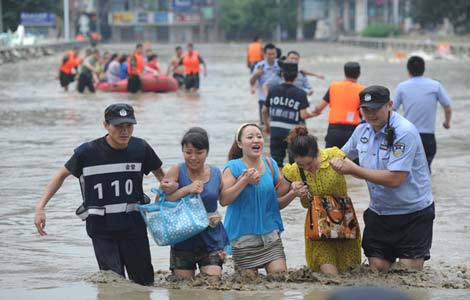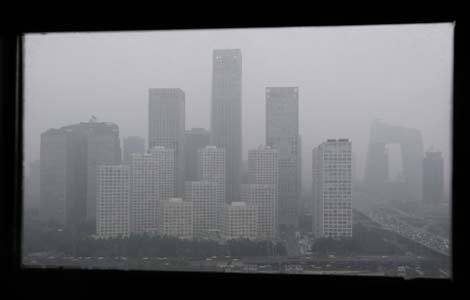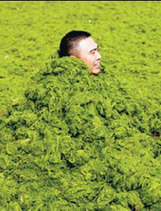Qingdao's algae problem fades after intense cleanup
Updated: 2013-07-10 08:09
By Xie Chuanjiao in Qingdao (China Daily)
|
||||||||
|
Tourists take photos last week in seawater covered in algae near a beach in Qingdao, Shandong province. The algae outbreak is now under control. Li Ziheng / Xinhua |
|
A tourist covers himself last week with algae that has invaded a beach in Qingdao, Shandong province. Mi Tongxi / for China Daily |
After a week's cleaning efforts, the biggest algae outbreak since 2008 in the coastal waters near Qingdao, Shandong province, is under control, with tourists and locals swarming to the beach once more.
Experts estimate that the algae will thoroughly vanish before August as the temperature rises.
Han Peijin, director of the No 6 sea bathing beach of Qingdao, is used to dealing with the algae every summer, and he is optimistic about the situation.
"More than 10,000 people came here on Sunday, and you could barely see the algae today," he told China Daily on Monday. "The algae blooms last less than a month, and it's under control now."
Local authorities have launched a special team to monitor and clean up the algae. Since June 8, 24,400 meters of netting has been laid in waters around the coasts of major tourist attractions, 230 fishing boats have collected 22,000 metric tons of algae, and 51,072 tons of algae brought ashore by waves has been removed by bulldozers. A large number of university students also volunteered to clean up the beach.
Liu Tao, an algae expert at the Ocean University of China, said the algae - or enteromorpha prolifera - will not survive when the water temperature goes above 23 C. Thus far, the water temperature is 19 C, "therefore although it looks well today, we still have to keep alert," he said.
"Besides, a large amount of precipitation will also kill the algae. A lack of rain is part of the reason for this year's outbreak."
Pang Shaojun, another ocean university researcher, said pollution and eutrophication are the primary cause of algae blooms, and the algae appearing in Qingdao has mainly drifted from South China.
Pang also said that how to deal with algae outbreaks has become a hot research point for scientists around the world.
"Harvested" algae is transported to local processing centers and used to make feed and fertilizer by companies, including China Ocean University Organism Project Development.
The company uses algae in three ways, namely feed additives, organic fertilizers and materials for healthcare products, said Shan Junwei, president of the company.
"Since 2008 we have developed quality algae fertilizers for fruit trees, vegetables, organic agriculture and urban gardening," he said.
"Hundreds of tons of bio-fertilizers made of algae have been sold to more than 20 provinces and regions."
The company is researching a method to extract polysaccharide from the algae for nutritional products.
xiechuanjiao@chinadaily.com.cn

(China Daily USA 07/10/2013 page6)

 Thousands pay final tribute to US firemen
Thousands pay final tribute to US firemen
 Dozens feared dead in Quebec derailment
Dozens feared dead in Quebec derailment
 Breathe deep, this is the real thing
Breathe deep, this is the real thing
 Families of crash victims in SF
Families of crash victims in SF
 Rainstorms cause severe flooding and landslides
Rainstorms cause severe flooding and landslides
 Coal burning in China's north can shorten lives
Coal burning in China's north can shorten lives
 Some solar companies see brighter first half
Some solar companies see brighter first half
 Thousands flock to Texas Capitol over abortion
Thousands flock to Texas Capitol over abortion
Most Viewed
Editor's Picks

|

|

|

|

|

|
Today's Top News
Watchdog: Trans-fat levels meet standards
Most passengers on crashed plane reported safe
China, US hold talks on cybersecurity
Shenzhen Red Cross denies organ claim
Rainstorms cause severe flooding and landslides
Japan tags China as 'security threat'
Honesty is a challenge for CPC
Snowden hasn't accepted asylum
US Weekly

|

|









